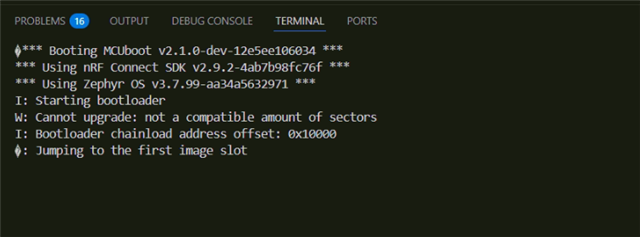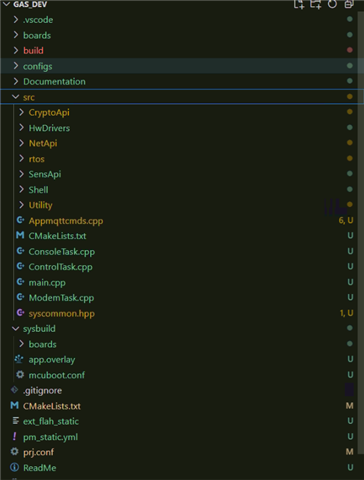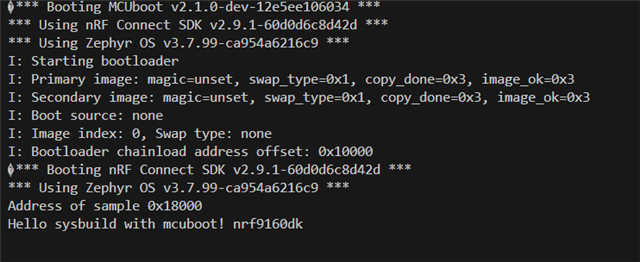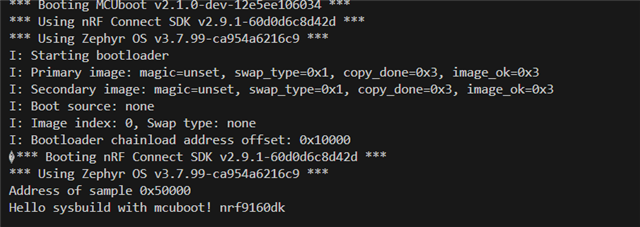NCS -> 2.9.2
Hi, guys
This will be little bit big of a ticket.
So I recently started working with nrf9160, and I have not much dabble with M33 core as well.
But anyways, so I started my project with nrf9160dk board, I have encryptions running on the system (HKDF,HMAC and CHACHA20-Poly1305), so as usual I have my application divided into secure (So keys gets stored here according to my understanding) and non-secure parts, overall the application is built now. So I decided to work on OTA now.
As I understand the MCUboot is automatically connected to your project using sysbuild and once proper config is enabled the MCUboot will take image from external flash secondary sector or internal flash whatever is set.
So my first goal was to simply enable mcuboot and see if my image is booted into primary sector, which obv failed at first because I was setting sectors in dts file, which I later got to know that in latest zephyr update , the partitions are being get from partition manager which you have define in pm_static.yml file. After playing around with pm_static.yml file I also studied more about partitioning that in nrf9160 sectors should be aligned with 0x8000, but I would say I finally got the hang of it and using a normal hello_world example I was able to boot into primary application from mcuboot.
So here is the first part of the problem My application cant boot to primary image from mcuboot
pm_static.yml
#include <autoconf.h>
EMPTY_0:
address: 0xF000
end_address: 0x10000
placement:
before:
- mcuboot_pad
region: flash_primary
size: 0x1000
EMPTY_1:
address: 0xE0000
end_address: 0x100000
placement:
after:
- mcuboot_secondary
region: flash_primary
size: 0x20000
app:
address: 0x68000
end_address: 0xD8000
region: flash_primary
size: 0x70000
mcuboot:
address: 0x0
end_address: 0xF000
placement:
before:
- mcuboot_primary
region: flash_primary
size: 0xF000
mcuboot_pad:
address: 0x10000
end_address: 0x10200
placement:
align:
start: 0x8000
before:
- mcuboot_primary_app
region: flash_primary
size: 0x200
mcuboot_primary:
address: 0x10000
end_address: 0xD8000
orig_span: &id001
- tfm
- mcuboot_pad
- app
region: flash_primary
sharers: 0x1
size: 0xC8000
span: *id001
mcuboot_primary_app:
address: 0x10200
end_address: 0xD8000
orig_span: &id002
- app
- tfm
region: flash_primary
size: 0xC7E00
span: *id002
otp:
address: 0xff8108
end_address: 0xff83fc
region: otp
size: 0x2f4
tfm:
address: 0x10200
end_address: 0x68000
inside:
- mcuboot_primary_app
placement:
before:
- app
region: flash_primary
size: 0x57E00
tfm_secure:
address: 0x10000
end_address: 0x68000
orig_span: &id008
- mcuboot_pad
- tfm
region: flash_primary
size: 0x58000
span: *id008
tfm_nonsecure:
address: 0x68000
end_address: 0xD8000
orig_span: &id007
- app
region: flash_primary
size: 0x70000
span: *id007
mcuboot_secondary:
address: 0xD8000
end_address: 0xE0000
placement:
after:
- mcuboot_primary
align:
start: 0x8000
align_next: 0x8000
region: flash_primary
share_size:
- mcuboot_primary
size: 0x8000
prj,conf
CONFIG_I2C=y CONFIG_SENSOR=y CONFIG_PM_DEVICE=y CONFIG_CRC=y CONFIG_SERIAL=y CONFIG_UART_ASYNC_API=y CONFIG_UART_INTERRUPT_DRIVEN=y CONFIG_HW_ID_LIBRARY=y # Newlib CONFIG_NEWLIB_LIBC=y CONFIG_HEAP_MEM_POOL_SIZE=4096 CONFIG_MAIN_STACK_SIZE=4096 CONFIG_NEWLIB_LIBC_FLOAT_PRINTF=y # SPI Flash CONFIG_SPI=y CONFIG_SPI_NOR=y CONFIG_NORDIC_QSPI_NOR=n # Enable flash operations. CONFIG_FLASH=y CONFIG_FLASH_MAP=y CONFIG_FLASH_PAGE_LAYOUT=y CONFIG_REBOOT=y # Image manager CONFIG_IMG_MANAGER=y CONFIG_IMG_ERASE_PROGRESSIVELY=y
mcuboot.conf
# Example of sample specific Kconfig changes when building sample with MCUboot # when using sysbuild. CONFIG_MCUBOOT_LOG_LEVEL_WRN=y CONFIG_MCUBOOT_DOWNGRADE_PREVENTION=y CONFIG_MCUBOOT_LOG_LEVEL_DEFAULT=y CONFIG_MCUBOOT_LOG_LEVEL_INF=y CONFIG_BOOT_MAX_IMG_SECTORS=256 # CONFIG_FLASH=y # CONFIG_MULTITHREADING=y # CONFIG_SPI=y # CONFIG_SPI_NOR=y # CONFIG_SPI_NOR_FLASH_LAYOUT_PAGE_SIZE=4096 # # Enable flash operations # CONFIG_PM_OVERRIDE_EXTERNAL_DRIVER_CHECK=y # CONFIG_PM_EXTERNAL_FLASH_MCUBOOT_SECONDARY=y # CONFIG_NORDIC_QSPI_NOR=n
sysbuild.conf
# Sysbuild configuration file. # Enable MCUboot per default for this sample. SB_CONFIG_BOOTLOADER_MCUBOOT=y #SB_CONFIG_SECURE_BOOT_APPCORE=y
zephyr generation partitions.yml
EMPTY_0:
address: 0xf000
end_address: 0x10000
placement:
before:
- mcuboot_pad
region: flash_primary
size: 0x1000
EMPTY_1:
address: 0xe0000
end_address: 0x100000
placement:
after:
- mcuboot_secondary
region: flash_primary
size: 0x20000
EMPTY_2:
address: 0xc2000
end_address: 0xc8000
placement:
after:
- tfm_its
region: flash_primary
size: 0x6000
app:
address: 0x68000
end_address: 0xc0000
region: flash_primary
size: 0x58000
external_flash:
address: 0x0
end_address: 0x800000
region: external_flash
size: 0x800000
mcuboot:
address: 0x0
end_address: 0xf000
placement:
before:
- mcuboot_primary
region: flash_primary
size: 0xf000
mcuboot_pad:
address: 0x10000
end_address: 0x10200
placement:
align:
start: 0x8000
before:
- mcuboot_primary_app
region: flash_primary
size: 0x200
mcuboot_primary:
address: 0x10000
end_address: 0xd8000
orig_span: &id001
- tfm
- mcuboot_pad
- app
region: flash_primary
sharers: 0x1
size: 0xc8000
span: *id001
mcuboot_primary_app:
address: 0x10200
end_address: 0xd8000
orig_span: &id002
- app
- tfm
region: flash_primary
size: 0xc7e00
span: *id002
mcuboot_secondary:
address: 0xd8000
end_address: 0xe0000
placement:
after:
- mcuboot_primary
align:
start: 0x8000
align_next: 0x8000
region: flash_primary
share_size:
- mcuboot_primary
size: 0x8000
mcuboot_sram:
address: 0x20000000
end_address: 0x20016000
orig_span: &id003
- tfm_sram
region: sram_primary
size: 0x16000
span: *id003
nrf_modem_lib_ctrl:
address: 0x20016000
end_address: 0x200164e8
inside:
- sram_nonsecure
placement:
after:
- tfm_sram
- start
region: sram_primary
size: 0x4e8
nrf_modem_lib_rx:
address: 0x20018568
end_address: 0x2001a568
inside:
- sram_nonsecure
placement:
after:
- nrf_modem_lib_tx
region: sram_primary
size: 0x2000
nrf_modem_lib_sram:
address: 0x20016000
end_address: 0x2001a568
orig_span: &id004
- nrf_modem_lib_ctrl
- nrf_modem_lib_tx
- nrf_modem_lib_rx
region: sram_primary
size: 0x4568
span: *id004
nrf_modem_lib_tx:
address: 0x200164e8
end_address: 0x20018568
inside:
- sram_nonsecure
placement:
after:
- nrf_modem_lib_ctrl
region: sram_primary
size: 0x2080
otp:
address: 0xff8108
end_address: 0xff83fc
region: otp
size: 0x2f4
sram_nonsecure:
address: 0x20016000
end_address: 0x20040000
orig_span: &id005
- sram_primary
- nrf_modem_lib_ctrl
- nrf_modem_lib_tx
- nrf_modem_lib_rx
region: sram_primary
size: 0x2a000
span: *id005
sram_primary:
address: 0x2001a568
end_address: 0x20040000
region: sram_primary
size: 0x25a98
sram_secure:
address: 0x20000000
end_address: 0x20016000
orig_span: &id006
- tfm_sram
region: sram_primary
size: 0x16000
span: *id006
tfm:
address: 0x10200
end_address: 0x68000
inside:
- mcuboot_primary_app
placement:
before:
- app
region: flash_primary
size: 0x57e00
tfm_its:
address: 0xc0000
end_address: 0xc2000
inside:
- tfm_storage
placement:
align:
start: 0x8000
before:
- tfm_otp_nv_counters
region: flash_primary
size: 0x2000
tfm_nonsecure:
address: 0x68000
end_address: 0xd8000
orig_span: &id007
- app
region: flash_primary
size: 0x70000
span: *id007
tfm_otp_nv_counters:
address: 0xc8000
end_address: 0xca000
inside:
- tfm_storage
placement:
align:
start: 0x8000
before:
- tfm_ps
region: flash_primary
size: 0x2000
tfm_ps:
address: 0xd0000
end_address: 0xd4000
inside:
- tfm_storage
placement:
align:
start: 0x8000
before:
- end
region: flash_primary
size: 0x4000
tfm_secure:
address: 0x10000
end_address: 0x68000
orig_span: &id008
- mcuboot_pad
- tfm
region: flash_primary
size: 0x58000
span: *id008
tfm_sram:
address: 0x20000000
end_address: 0x20016000
inside:
- sram_secure
placement:
after:
- start
region: sram_primary
size: 0x16000
tfm_storage:
address: 0xc0000
end_address: 0xd4000
orig_span: &id009
- tfm_ps
- tfm_its
- tfm_otp_nv_counters
region: flash_primary
size: 0x14000
span: *id009
The output

And the funny thing is sometimes it boots into application but after hours of waiting here. As I left it like this yesterday and the application was booted and I again restarted the mcu the application got stuck here
Here is my project folder setup

and here are my project based .conf files which have encryption and other stuff activated
C_PLUS_PLUS.conf
CONFIG_CPP=y CONFIG_REQUIRES_FULL_LIBCPP=y CONFIG_STD_CPP20=y CONFIG_NEWLIB_LIBC=y
crypto.conf
# ---------- TF-M integration ---------- CONFIG_TFM_PROFILE_TYPE_NOT_SET=y # pick secure services by hand # ---------- nRF Security + PSA layer ---------- CONFIG_NRF_SECURITY=y CONFIG_MBEDTLS_PSA_CRYPTO_C=y # ---------- use CryptoCell hardware driver ---------- CONFIG_PSA_CRYPTO_DRIVER_CC3XX=y CONFIG_PSA_CRYPTO_DRIVER_OBERON=y # ---------- algorithms & key-types ---------- CONFIG_PSA_WANT_ALG_ECDH=y CONFIG_PSA_WANT_KEY_TYPE_ECC_KEY_PAIR_GENERATE=y CONFIG_PSA_WANT_KEY_TYPE_ECC_KEY_PAIR_IMPORT=y CONFIG_PSA_WANT_KEY_TYPE_ECC_KEY_PAIR_EXPORT=y #CONFIG_PSA_WANT_ECC_CURVE_CURVE25519=y #following gives Curve25519 support CONFIG_PSA_WANT_ECC_MONTGOMERY_255=y #---------- key-derivation & hash for post-ECDH ---------- CONFIG_PSA_WANT_ALG_HKDF=y CONFIG_PSA_WANT_ALG_SHA_256=y CONFIG_PSA_WANT_ALG_HMAC=y CONFIG_PSA_WANT_KEY_TYPE_HMAC=y #----------- CHACHA20 poly1305 ------------- CONFIG_PSA_WANT_KEY_TYPE_CHACHA20=y CONFIG_PSA_WANT_ALG_CHACHA20_POLY1305=y # ---------- entropy source for key generation ---------- CONFIG_PSA_WANT_GENERATE_RANDOM=y
logging.conf
CONFIG_LOG=y CONFIG_LOG_BUFFER_SIZE=4096 CONFIG_LOG_BACKEND_UART=y CONFIG_SHELL_LOG_BACKEND=n # ← disable log-to-shell # --- Shell core ------------------------------------------------- CONFIG_SHELL=y CONFIG_SHELL_STACK_SIZE=5120 CONFIG_SHELL_PROMPT_UART="gasSensor: " CONFIG_SHELL_CMD_ROOT="gasSensor" CONFIG_SHELL_BACKEND_SERIAL=y #CONFIG_SHELL_PROMPT="gas> " # prompt string # --- turn OFF all built-in command groups -------------------------- CONFIG_SHELL_CMDS=n # generic cmds: clear, history, resize, retval CONFIG_DEVICE_SHELL=n # device, devmem CONFIG_DEVMEM_SHELL=n CONFIG_KERNEL_SHELL=n # kernel timing, stacks, uptime, ... # (optional) keep command history? CONFIG_SHELL_HISTORY=n # turn off if you don’t need ↑ key recall
lte.conf
CONFIG_NRF_MODEM_LIB=y CONFIG_LTE_LINK_CONTROL=y CONFIG_LTE_NETWORK_MODE_LTE_M_NBIOT=y #ONFIG_AT_HOST_LIBRARY=y #power saving CONFIG_LTE_LC_EDRX_MODULE=y CONFIG_LTE_LC_PSM_MODULE=y CONFIG_LTE_PSM_REQ=y CONFIG_LTE_EDRX_REQ=y
mqtt,networking and tls conf
# MQTT CONFIG_MQTT_LIB=y CONFIG_MQTT_CLEAN_SESSION=y # Networking CONFIG_NETWORKING=y CONFIG_NET_NATIVE=n CONFIG_NET_SOCKETS_OFFLOAD=y CONFIG_NET_SOCKETS=y CONFIG_POSIX_API=y CONFIG_MODEM_KEY_MGMT=y CONFIG_MQTT_LIB_TLS=y
I will get back to external flash mcuboot issue later but first I want to boot into my normal application as a normal bootloader






